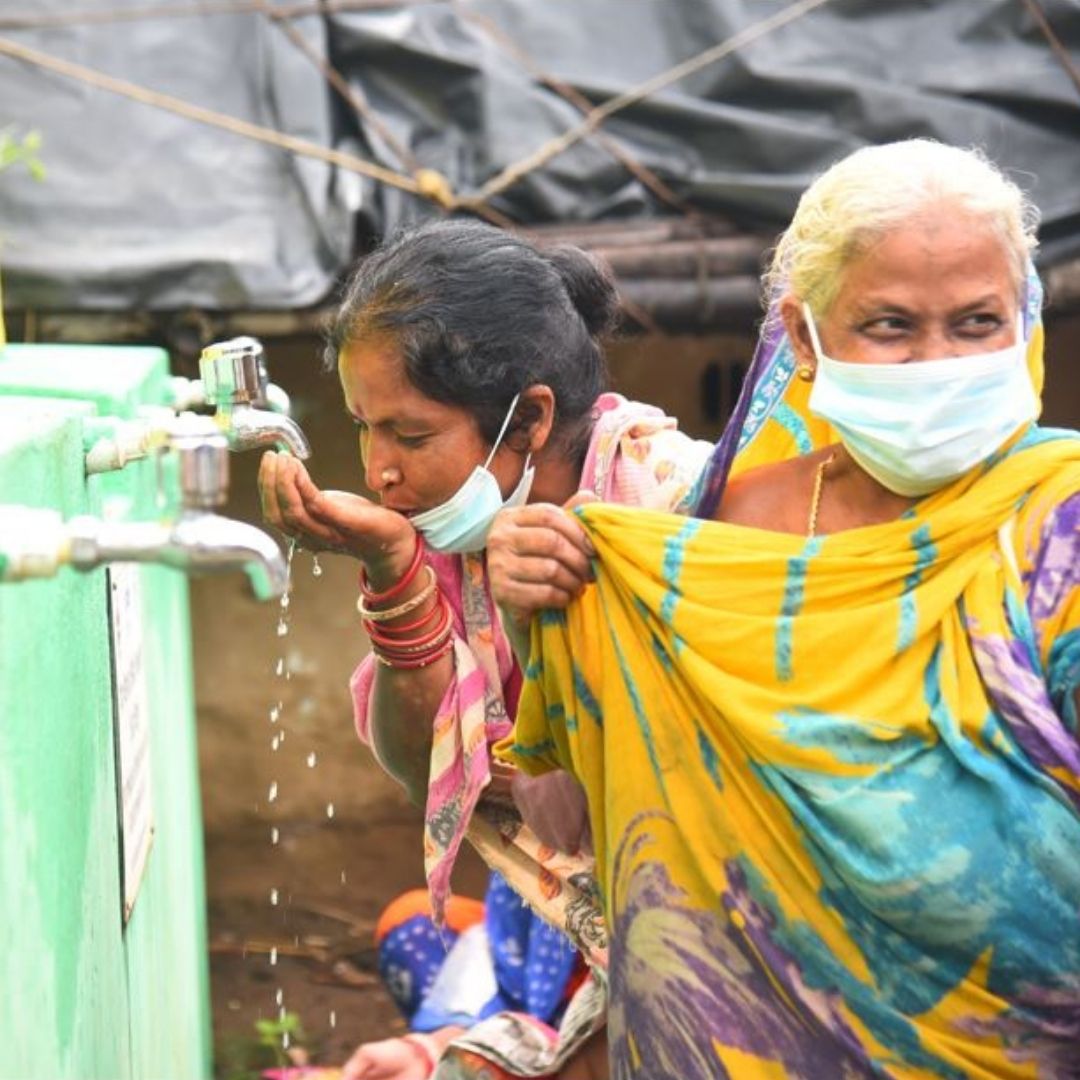
Image Credits: Tofan Biswal (From The Source)
Clean Water & Better Health For Villagers: A Solution For Overworked Women In Odisha
Writer: Rakhi Ghosh
Rakhi Ghosh is an independent journalist based out of Bhubaneswar. She has worn several awards for reporting from rural India and on issues related to women and children, environment, health, education and human rights.
Odisha, 27 Nov 2021 4:29 AM GMT | Updated 1 Dec 2021 2:12 PM GMT
Creatives : Akanksha Saxena |
I am a budding journalist who loves to write stories that have the ability to connect with people.
Guest Author : Rakhi Ghosh
Rakhi Ghosh is an independent journalist based out of Bhubaneswar. She has worn several awards for reporting from rural India and on issues related to women and children, environment, health, education and human rights.
People living in different villages in Kanas block, situated 36 km from Puri town and only 15-20 km away from Chilika Lake, have suffered for years to get clean drinking water. The main source of water, on which they are dependent, are tube wells with saline water and very high levels of iron. Villagers always complained of stomach ailments, skin problems and diarrhoea.
"These days when our relatives come to visit us they drink water from our home," says Alaka Swain, 38, of Kaudikhani village under Kadua Gram Panchayat in Kanas block of Odisha's Puri district, while showing the water stored in a plastic bottle. "See these bottles do not turn yellow like before. We are now getting clean water like you people get in your homes," she says with a smile.
Things were quite different a few years back. People living in different villages in Kanas block, situated 36 km from Puri town and only 15-20 km away from Chilika Lake, have suffered for years to get clean drinking water. The main source of water, on which they are dependent, are tube wells with saline water and very high levels of iron. Villagers always complained of stomach ailments, skin problems, and diarrhoea.
"Most of our containers—pitchers, buckets, and other vessels—used to turn yellow because of high iron content. It was salty with very bad odour. During floods the contaminated floodwater would enter tube wells forcing women to search for other sources to collect water," says Tukuni Swain, another woman from the village.
To avoid the water with iron, bad odour, and bad taste, women of Harihara Patna village in Kanas block used to walk 8-10 km daily to Luna River, a tributary of River Daya, to collect water for their families. "Even pregnant women, in advanced stages, ended up walking long distances to fetch potable water," says Damayanti Behera. She adds that during monsoon (chaturmasa) most of the villagers used to suffer from water-borne diseases such as diarrhoea, dysentery, jaundice, and stomach pain. Children ended up suffering the most.
The river water they collected for drinking and for household needs was polluted and contaminated, especially during monsoons as all the waste from Bhubaneswar was dumped into the tributary of Daya River. During Cyclone Phailin and Cyclone Fani, which hit the Odisha coast in 2013 and 2019 respectively, villagers faced difficulty in accessing clean drinking water. After the IRP was set up in these villages people were able to get clean water. Moreover, their frequent visit to PHC and CHC for the treatment of water-borne diseases also reduced drastically.
Demand from locals
Solar, a Puri-based non-profit organisation with the support of Oxfam India and Livpure foundation set up its first Iron Removal Plant (IRP) in Ogalpur and subsequently in a few other villages in Kanas. This sent out the message that clean drinking water could be available at the doorsteps of the villagers. This saw a rise in demand from other villages to install IRPs in theirs too. Kaudikhani was one such village.
In 2016, the Sarpanch of Kaudikhani village and a few villagers heard about the Iron Removal Plant (IRP). "We immediately approached the organisation after a brief discussion and testing of water quality they installed IRP in Kaudikhani village in 2017," says Aparti Swain, former Sarpanch of Kaudikhani.
The IRP has a capacity of 2,000 litres and is filled four times a day to cater to the 700-odd population of Kaudikhani. The motor pump lifts the water into the top chamber of the IRP and the filtered water is collected in lower chambers. The tube well water that gets filtered through the IRP is iron-free and free of bad smell and taste. "With the installation of IRP, villagers are now getting sufficient and clean water to meet their drinking and cooking needs," Aparti adds.
In Karamala Beherasahi, Ward Member Mrityunjay Behera, cognisant of the burden of collecting and storing water on women, raised the issue at a Disaster Risk Reduction (DRR) meeting. "I approached the staff from SOLAR to visit our village and assess the need for installing an IRP as the women spent hours on trying to collect clean, drinking water."
After the installation of IRP in 2017 now women are happy as clean drinking water is available at their doorstep. They don't have to spend hours collecting, boiling, and storing water. "Now water from IRP tastes good and we are also using it for cooking purposes too," says Jashoda Behera. Oxfam India and SOLAR have installed 15 IRPs in Kanas, seven in Brahmagiri, and three in Satyabadi blocks. "There few ongoing projects to keeping the demand of the locals", said Chitta Parida, Programme Manager Solar NGO.
Setting up of IRPs
The cost for setting up one IRP is a little more than Rs 2 lakh. "Villagers of different blocks are demanding to install Iron removal plants in their villages. The Sarpanchs and block administration are also convinced that there is a need to set up such technology with the existing tube wells to provide clean water to the villagers. But there are some bottlenecks. There needs to be state-level advocacy for policy changes then Sarpanchs can invest in setting up of IRPs from panchayat fund," said Chitta. He added, "If that happens more IRPs will be installed in different villages and Oxfam India can provide the technical know-how for the plant".
The State government also adopted the concept and replicated it in a few villages of Kanas and Brahmagiri blocks, but the technology is quite different from IRP. Villagers allege they are not getting clean water and both saline and iron content is not totally removed after filtration.
As IRP provides clean drinking water, villagers are spending enough time, effort, and money to keep the surroundings of the tank and the tank clean. Every month villagers collect Rs 30 from each family for maintenance expenditures such as cleaning of the surroundings and tank, bleaching, and candle replacement. "Villagers happily participate in cleaning work as there is a sense of ownership in it," says Sushama Swain, Secretary of the Water and Sanitation (WASH) Committee of Kaudikhani village.
Positive Impact
Alaka married in Kaudikhani village said, "Since childhood, I have seen my bou and mausi and other women in the village toiling hard to collect water and then spend hours in boiling, cooling and storing it for drinking and cooking purposes. From morning till the time they went to bed they were engaged in household work, and collecting and storing water formed a major part of their day's work". She also went through the same ordeal soon after her marriage but with the installation of IRP now the women are able to get some rest, which was not possible earlier.
Like everywhere else women here too are responsible for collecting, storing, and cleaning water—this is an unpaid care work that is thrust upon them. "We often were suffered from unbearable body ache," says Harasmani Pradhan adding that the IRP has provided relief to them from body pain.
During the pandemic, when the government insisted on regular hand washing, women are happy that IRP has reduced their work burden as that washing facility is now available at their doorstep. Besides, after the installation of IRP, the cases of stomach ailments have drastically reduced in these villages.
Rakhi Ghosh is an independent journalist based out of Bhubaneswar. She has won several awards for reporting from rural India and on issues related to women and children, environment, health, education, and human rights. The story was written as part of an assignment for Oxfam India in Puri, Orissa.
Also Read: All Capitals Of Northeastern States To Be Connected With Airports By 2024
 All section
All section















